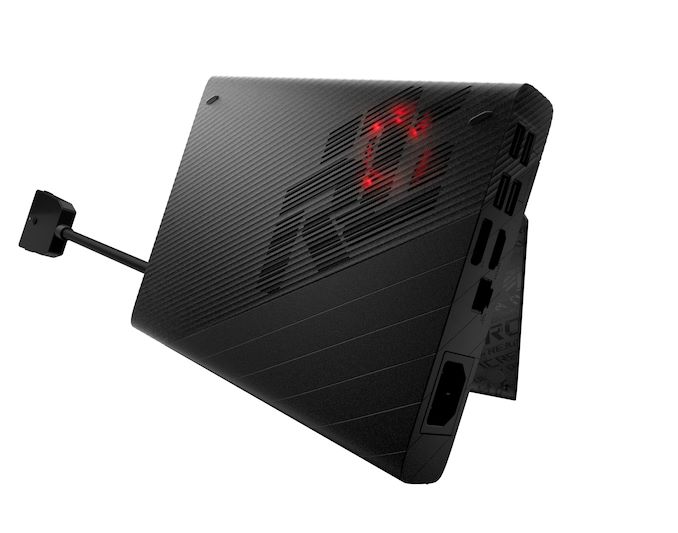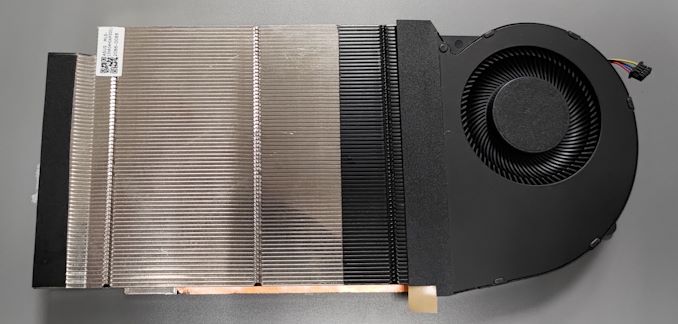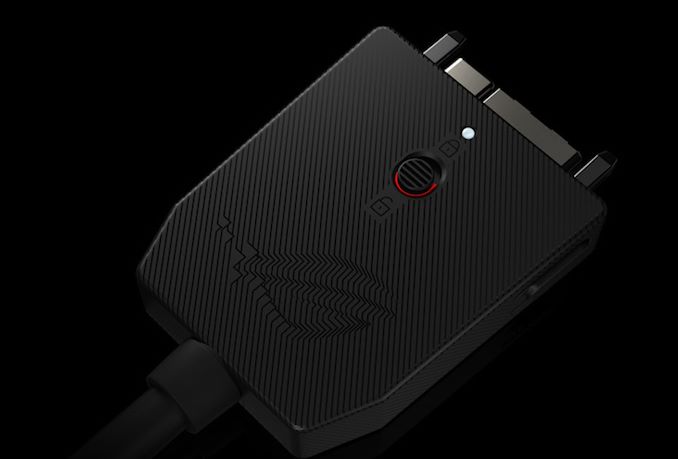CES 2021: ASUS ROG XG Mobile, An External Graphics Dock For ROG Flow X13
by Gavin Bonshor on January 13, 2021 3:00 PM EST- Posted in
- Laptops
- Asus
- ROG
- External GPU
- Trade Shows
- RTX
- CES 2021
- Flow X13
- GV301

Alongside ASUS's announcement of its latest ROG Flow X13 13-inch gaming notebook, it has also unveiled an interesting new external graphics dock to go with that notebook. Dubbed the ROG XG Mobile GV301, the external graphics dock is designed to augment the ROG Flow X13's capabilities, turning it into a powerful and lightweight portable gaming rig. And though graphics docks themselves are nothing new, this one stands out due to its portability, with the dock being similar in size to a second laptop.
From a high-level perspective, the graphics dock lives up to its name. At its heart, of course, is a high-performance GPU, with ASUS tapping NVIDIA’s new laptop-grade RTX 3070 and 3080 adapters, both of which will be a significant step up from the Flow X13’s built-in GeForce GTX 1650 graphics adapter. Along with this, the dock can power the Flow X13 – thanks to its integrated 280W power supply – and offers several ports including HDMI and DisplayPort, a Gig Ethernet jack, 4 USB-A 3.2 Gen 1 ports, and an integrated SD card reader.
Notably, like some past efforts to provide graphics docks for thin & light laptops, ASUS is going with a proprietary connection here rather than relying on Thunderbolt. The unnamed connector is split intwo two segments, with one carrying PCIe 3.0 x8 data while the other segment is a USB-C connector for carrying power and USB data. This significantly limits the compatibility of the dock, but it does provide twice as much PCIe bandwidth as Thunderbolt 3 or 4 otherwise would.
As previously mentioned, one of ASUS’s design goals for the ROG XG Mobile is portability, so that it can be carried around with the Flow X13 rather than serving as a relatively static dock at home. To that end the dock is 29.6mm thick, with a 208mm x 155mm footprint, making it comparable in size to a second laptop. It also weighs similar (if a bit denser) at a flat 1kg (2.2lbs). Fittingly, ASUS is supplying a sleeve with the Flow X13 to carry both the laptop and XG Mobile, simplifying this process some.

The thermal solution on the ASUS ROG XG Mobile
The ROG XG Mobile is due this quarter, with pricing to be announced.
Interested in more of the latest industry news? Check out our CES 2021 trade show landing page!
Source: ASUS







_thumb.jpg)
_thumb.jpg)
_thumb.jpg)








21 Comments
View All Comments
Spunjji - Thursday, January 14, 2021 - link
Those all used PCIe 4x, so the performance improvement was not great.That said, the Alienware Amplifier survived for 3 generations of notebooks and covered 5 generations of GPU - not a bad run, really.
Digital COrpus - Friday, January 15, 2021 - link
Internally the X13 split into 2, x4 connectors. Don't see much of a reason to do this unless they're dedicating the peripherals to a x4 bus. Discrete GPU I bet is internally on x8 because bifurcation topology of x8/x4/x4 is a thing. In other words, I bet that this still runs the GPU on a x4 bus. However, if its PCIe 4, not 3, that won't be a problem.Spunjji - Monday, January 18, 2021 - link
Per the article:"The unnamed connector is split into two segments, with one carrying PCIe 3.0 x8 data while the other segment is a USB-C connector for carrying power and USB data."
It's PCIe 3.0 and the GPU is run on 8x, not 4x. The peripheral parts run over USB-C.
Tams80 - Sunday, January 17, 2021 - link
Despite AnandTech not noticing the OCuLink connector, they did explain that in the article.I suggest you read it.
Spunjji - Thursday, January 14, 2021 - link
Pending costs and noise/performance tests, this could be very interesting indeed - especially the 3070 variant.Valantar - Friday, January 15, 2021 - link
This looks like a very well-engineered solution. Good on Asus for making what IMO is what eGPUs should have been like all along. The proprietary connector is a bummer, but also understandable. Not Asus' fault, ultimately.One question: does the laptop-side USB-C port in this dock port work as a normal USB-C?
Also, saying this is "comparable in size to a second laptop" is grossly misleading, unless your concept of "laptop" is one of those niche ultraportable 7" GPD devices. This is compact and thick, more like a paperback novel than a notepad in size. The volume and weight are indeed likely laptop-like, but not the shape.
Spunjji - Monday, January 18, 2021 - link
You're right on the last point, but I think the intent was to point out that it doesn't have the bulk of eGPU boxes that are merely carriers for a desktop add-in card and a server PSU.s.yu - Friday, January 15, 2021 - link
Nobody here is saying that it uses the L version of the GPUs...I just assumed that from the size but...kindesflaye - Friday, January 15, 2021 - link
What are the odds Asus will offer additional compatible laptops? Like a Flow x14 or x15 - something with similar specs but larger battery and a little more display area? A 14-15" 16:10 version would be amazing.Tams80 - Sunday, January 17, 2021 - link
The connector alongside the USB C one is an OCuLink one, which is part of the PCIe specification.So really, only the housing is proprietary.
I know it is a very rarely used connector, but come on AnandTech. You can do better than this.